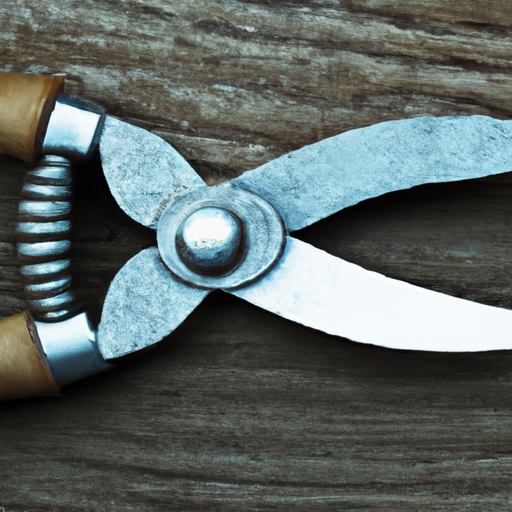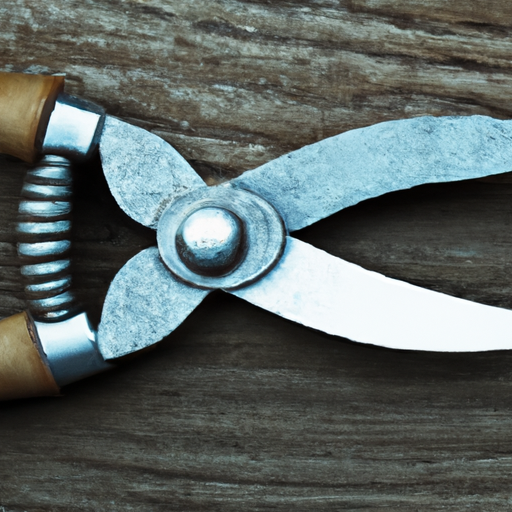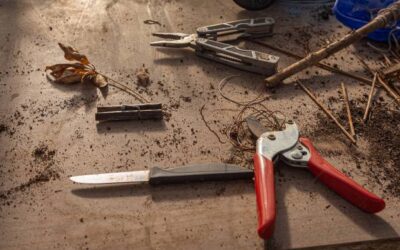In this article, you will learn about the do’s and don’ts of cleaning Japanese garden tools. Taking care of your tools is essential to ensure they last for a long time and perform their best. By following these tips, you can keep your Japanese garden tools in excellent condition and enjoy their beauty and functionality for years to come.
When it comes to cleaning Japanese garden tools, there are a few do’s to keep in mind. First, do wipe the tools with a clean cloth after each use to remove dirt and moisture. This will help prevent rust and keep the tools looking their best. Second, do use a mild detergent or soap and water solution to clean your garden tools, and be sure to rinse them thoroughly and dry them completely afterwards. Lastly, do oil the metal parts of your tools regularly to prevent rust and keep them in good working condition. Following these do’s will help extend the lifespan of your Japanese garden tools and ensure they continue to perform at their best.
Introduction
Japanese garden tools are known for their craftsmanship, precision, and durability. These tools, such as pruning shears, hoes, and rakes, are essential for maintaining the beauty and serenity of a Japanese garden. However, to ensure that your tools remain in optimal condition and continue to perform at their best, proper cleaning and maintenance are necessary. In this article, we will explore the benefits of Japanese garden tools, the importance of proper maintenance, and provide you with a comprehensive guide on how to clean, dry, sharpen, and protect your tools.
Benefits of Japanese Garden Tools
Japanese garden tools are highly regarded for several reasons. Firstly, they are made with high-quality materials and designed using traditional techniques that have been perfected over centuries. This craftsmanship results in tools that are not only functional but also aesthetically pleasing. The attention to detail and the use of natural materials create a sense of harmony and elegance, which aligns perfectly with the principles of a Japanese garden.
In addition to their visual appeal, Japanese garden tools are also known for their durability. These tools are built to withstand regular use in a variety of weather conditions. Whether you are tending to a small personal garden or maintaining a larger outdoor space, investing in Japanese garden tools will ensure that you have reliable and effective tools that will stand the test of time.

Importance of Proper Maintenance
Proper maintenance is crucial for preserving the longevity and performance of your Japanese garden tools. By following the right cleaning techniques and taking proactive measures, you can prevent rust, maintain sharpness, and keep your tools in optimal condition. Regular maintenance not only extends the lifespan of your tools but also ensures that they continue to function effectively, allowing you to achieve the desired results in your garden.
Cleaning Do’s
When it comes to cleaning your Japanese garden tools, there are a few important do’s that you should keep in mind. By following these gentle cleaning techniques, you can effectively remove dirt and debris without causing any damage to the tools themselves.
Gentle Cleaning Techniques
Start by using a soft brush or cloth to gently remove any loose dirt or dust from the surface of your tools. This will help prevent any unnecessary scratching or abrasion. Be sure to pay attention to hard-to-reach areas, such as the crevices between blades or handles.
Using Mild Soap and Water
Once the initial dirt and dust have been removed, you can proceed to clean your tools using mild soap and water. Fill a bucket or basin with warm water and add a small amount of mild dish soap or hand soap. Use a sponge or cloth soaked in this soapy solution to gently scrub the surfaces of your tools. Ensure that you rinse off all the soap residue thoroughly.
Removing Dirt and Debris
In addition to general cleaning, it is important to remove any stubborn dirt or debris that may be stuck to your tools. For this purpose, you can use a toothbrush or a small brush with stiff bristles. Apply some soap or water to the brush and scrub the affected areas until the dirt or debris is loosened. Rinse off the residue and dry the tools thoroughly.

Cleaning Don’ts
While there are specific cleaning techniques that you should follow, there are also certain cleaning practices that you should avoid as they can potentially damage your Japanese garden tools.
Avoid Harsh Chemicals
Harsh chemicals, such as bleach or abrasive cleaners, should be avoided when cleaning your tools. These chemicals can cause corrosion, discoloration, or even weaken the structure of the tools. Stick to gentle cleaning solutions, such as mild soap and water, to ensure the longevity of your tools.
Do Not Use High-Pressure Washing
Avoid using high-pressure washing equipment, such as pressure washers, to clean your Japanese garden tools. The force of the water can be too strong and may cause damage to the delicate parts of the tools, such as the blades or handles. Stick to gentle cleaning techniques to preserve the integrity of your tools.
Avoid Soaking for Extended Periods
While it is important to thoroughly clean your tools, avoid soaking them in water for extended periods. Prolonged exposure to moisture can lead to rust or corrosion, especially if your tools are made of carbon steel. Clean your tools promptly and dry them thoroughly to prevent any moisture-related damage.
Drying and Storage
Proper drying and storage are crucial steps in maintaining the condition of your Japanese garden tools. By following these guidelines, you can prevent rust and ensure that your tools are ready for use when you need them.
Air-Drying Tools
After cleaning your tools, it is important to dry them thoroughly before storing them. Wipe off any excess moisture using a clean towel or cloth. To promote air circulation, you can also leave your tools in a well-ventilated area, such as a shed or garage, for a few hours. This will ensure that any remaining moisture evaporates, minimizing the risk of rust.
Preventing Rust
To prevent rust, especially on tools made of carbon steel, it is recommended to apply a thin layer of oil or a rust inhibitor. This protective coating creates a barrier between the metal surfaces of your tools and moisture in the air, preventing oxidation. Be sure to follow the manufacturer’s instructions when applying these coatings and reapply them periodically as needed.
Proper Storage Methods
When it comes to storing your Japanese garden tools, it is important to keep them in a dry and clean environment. Store your tools in a tool shed, cabinet, or designated storage area where they are protected from moisture, dust, and direct sunlight. You can also consider hanging your tools on a pegboard or using a tool rack to keep them organized and easily accessible.
Sharpening and Maintenance
Regular sharpening and maintenance are essential for keeping your Japanese garden tools in optimal condition. By following these steps, you can maintain sharpness, ensure proper functionality, and extend the lifespan of your tools.
Regular Sharpening
Keep your Japanese garden tools sharp by regularly sharpening their blades. Dull blades can make your gardening tasks more difficult and can cause damage to plants. Use a sharpening stone or file to maintain the edge of your tools’ blades. Follow the manufacturer’s instructions and apply consistent pressure and angle when sharpening.
Using Correct Tools for Sharpening
Using the correct tools for sharpening is essential to avoid damaging the blades. Japanese garden tools often have unique blade profiles that require specific sharpening techniques. Invest in sharpening tools that are designed for Japanese garden tools, such as whetstones or ceramic sharpeners. These tools are specifically designed to maintain the precision and integrity of Japanese garden tool blades.
Oiling and Lubrication
In addition to sharpening, proper lubrication can help maintain the performance and condition of your tools. Apply a few drops of oil to the moving parts of your tools, such as pivot points or joints, to prevent friction and ensure smooth operation. Use a lightweight oil, such as mineral oil or sewing machine oil, and wipe off any excess to avoid attracting dirt or dust.
Protective Measures
Protective measures are important for ensuring your safety while using Japanese garden tools and preserving the integrity of the tools themselves. By following these guidelines, you can minimize the risk of injury and maintain the quality of your tools.
Using Gloves and Eye Protection
When working with Japanese garden tools, it is advisable to wear gloves and eye protection. Gloves provide a layer of protection against cuts, blisters, and splinters, while eye protection, such as safety goggles, shields your eyes from debris or dust. These protective measures not only promote safety but also enhance your comfort and efficiency while gardening.
Applying Protective Coatings
To further protect your tools from rust and corrosion, consider applying protective coatings to their surfaces. There are specialized coatings available, such as blade oils or waxes, that provide an additional layer of protection against moisture and other environmental factors. Apply these coatings according to the manufacturer’s instructions and periodically reapply as needed.
Maintaining Tool Handles
Tool handles are often made of wood, which requires specific maintenance to prevent cracking or splintering. Regularly inspect the handles for any signs of wear or damage. If necessary, sand down rough or splintered areas and apply a coat of wood oil or varnish to keep the handles smooth and protected.
Inspection and Replacement
Regular inspection is essential for identifying any damage or wear on your Japanese garden tools. By promptly addressing any issues and replacing damaged tools, you can ensure their continued functionality and safety.
Regular Inspection for Damage or Wear
Regularly inspect your tools for any signs of damage, wear, or loosening of parts. Check the blades for chipping or bending, handles for cracks or splinters, and joints for any signs of weakness. Address any issues immediately to prevent further damage and ensure the safe use of your tools.
Replacing Damaged Tools
If a tool is severely damaged or beyond repair, it is important to replace it promptly. Using damaged tools can not only hinder your gardening efforts but also pose a safety risk. Invest in high-quality replacements to maintain the performance and longevity of your Japanese garden tool collection.
Investing in High-Quality Tools
When purchasing Japanese garden tools, it is important to invest in high-quality tools from reputable manufacturers. While they may come with a higher price tag, these tools are built to last and are often backed by warranties. By investing in quality tools, you can have peace of mind knowing that your tools are reliable and will withstand the rigors of regular use.
Professional Assistance
There may be instances where professional assistance is required for the maintenance of your Japanese garden tools. Knowing when to seek professional help and finding skilled tool maintenance services can ensure that your tools receive the care and attention they need.
When to Seek Professional Help
If you encounter complex or extensive damage to your tools, it is advisable to seek professional help. Professionals have the knowledge, expertise, and specialized equipment to handle repairs or restoration work on Japanese garden tools. Additionally, if you are unsure of how to properly maintain or sharpen your tools, consulting with professionals can provide valuable guidance.
Finding Skilled Tool Maintenance Services
To find skilled tool maintenance services, start by asking for recommendations from fellow gardeners or local gardening centers. Alternatively, you can search online for businesses that specialize in the maintenance and repair of Japanese garden tools. When choosing a service, ensure that they have experience working with Japanese garden tools and that they prioritize quality workmanship.
Conclusion
Proper cleaning and maintenance are essential for preserving the longevity and performance of Japanese garden tools. By following the do’s and don’ts of cleaning, ensuring proper drying and storage, sharpening and maintaining your tools, practicing protective measures, regularly inspecting and replacing damaged tools, and seeking professional assistance when necessary, you can enhance the longevity and performance of your Japanese garden tools. With a little care and attention, your tools will continue to serve you well as you enjoy the beauty and tranquility of your Japanese garden.








